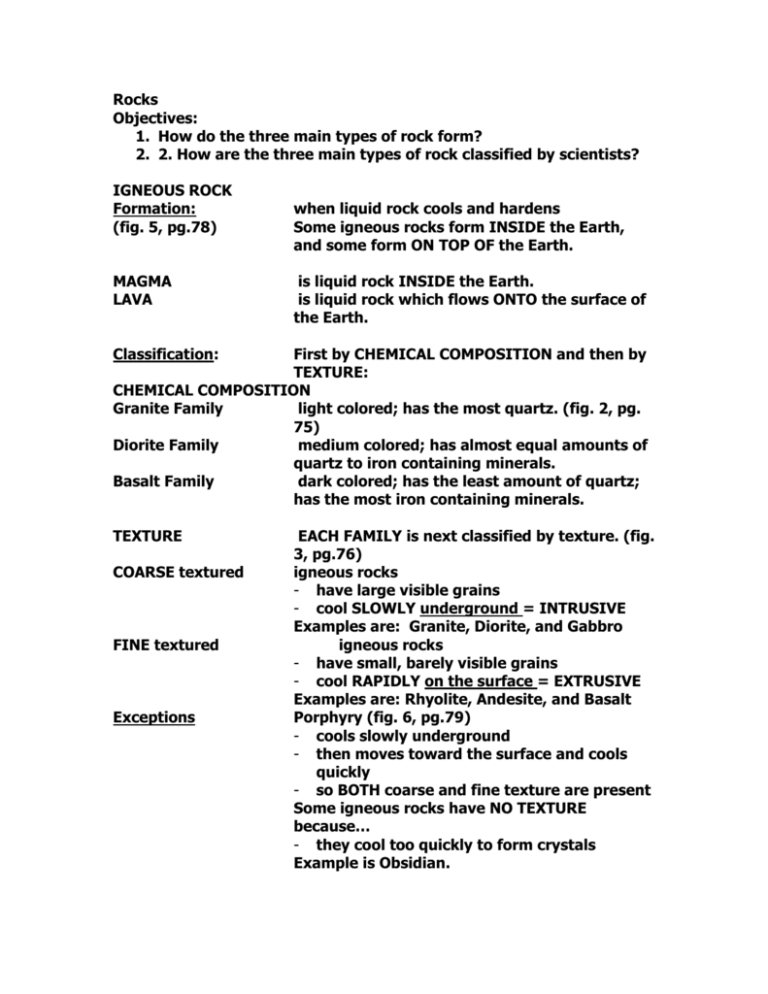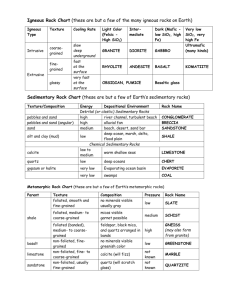IGNEOUS ROCK - Solon City Schools
advertisement

Rocks Objectives: 1. How do the three main types of rock form? 2. 2. How are the three main types of rock classified by scientists? IGNEOUS ROCK Formation: (fig. 5, pg.78) MAGMA LAVA when liquid rock cools and hardens Some igneous rocks form INSIDE the Earth, and some form ON TOP OF the Earth. is liquid rock INSIDE the Earth. is liquid rock which flows ONTO the surface of the Earth. Classification: First by CHEMICAL COMPOSITION and then by TEXTURE: CHEMICAL COMPOSITION Granite Family light colored; has the most quartz. (fig. 2, pg. 75) Diorite Family medium colored; has almost equal amounts of quartz to iron containing minerals. Basalt Family dark colored; has the least amount of quartz; has the most iron containing minerals. TEXTURE COARSE textured FINE textured Exceptions EACH FAMILY is next classified by texture. (fig. 3, pg.76) igneous rocks - have large visible grains - cool SLOWLY underground = INTRUSIVE Examples are: Granite, Diorite, and Gabbro igneous rocks - have small, barely visible grains - cool RAPIDLY on the surface = EXTRUSIVE Examples are: Rhyolite, Andesite, and Basalt Porphyry (fig. 6, pg.79) - cools slowly underground - then moves toward the surface and cools quickly - so BOTH coarse and fine texture are present Some igneous rocks have NO TEXTURE because… - they cool too quickly to form crystals Example is Obsidian. - thick, bubbling lava cools with many holes, and without crystals Example is Pumice. SEDIMENTARY Rocks Formation: (fig. 9, pg.83) By CEMENTATION, which is the process of sediments (small pieces of rock) getting coated with natural cements, and then binding together. Classification: Into 3 Main Types: CLASTIC Sedimentary Rocks (fig.10, pg.84) - Are fragments of rocks and minerals that get deposited usually by water or wind, then cement together. - Are grouped by the size of the sediments. - the smallest are CLAYS -an example is Shale - the medium are SANDS -an example is Sandstone - the largest are PEBBLES -an example is Conglomerate CHEMICAL - ORGANIC Sedimentary Rocks (fig. 13, pg.86) - Form from minerals once dissolved in water. - Are formed by one of the following processes: -evaporation then cementation, these are called EVAPORITES, an example is Halite -precipitation then cementation, these are called PRECIPITATES, and example is Chert Sedimentary Rock (fig.18, pgs. 90 & 91) - Form from the remains of animals (shells, bones) cemented together, an example is Coquina. - Form from decayed plant material over millions of years, and example is Coal. METAMORPHIC ROCK Formation: Classification: There are 2 Types: 1. FOLIATED 2. UNFOLIATED Intense heat and pressure of an existing Igneous, Sedimentary, or even another Metamorphic rock can actually change the texture and mineral content of the rock into a new rock. Examples are: - sandstone to quartzite - shale to slate - slate to phyllite to schist - schist to gneiss which contain obvious layers An example is Gneiss. which is without obvious layers An example is Marble. (fig. 19, pg.92)







